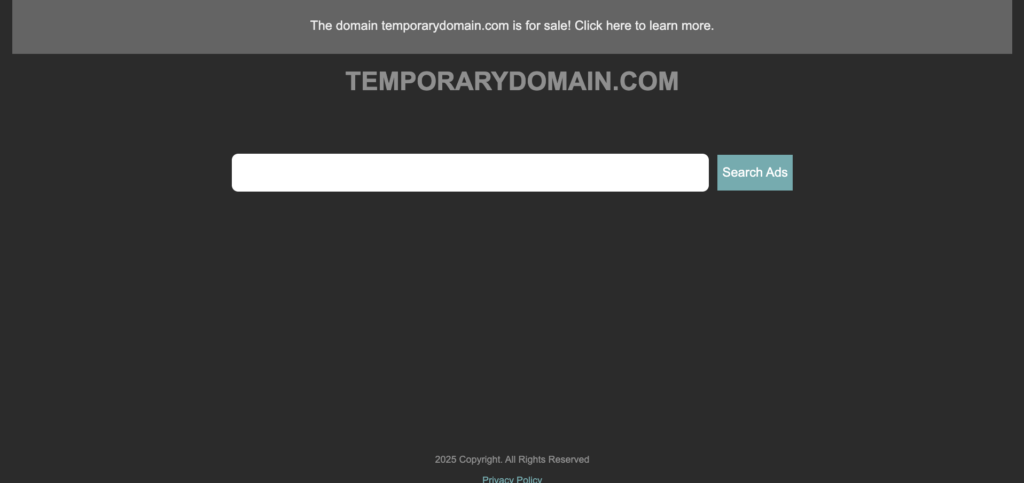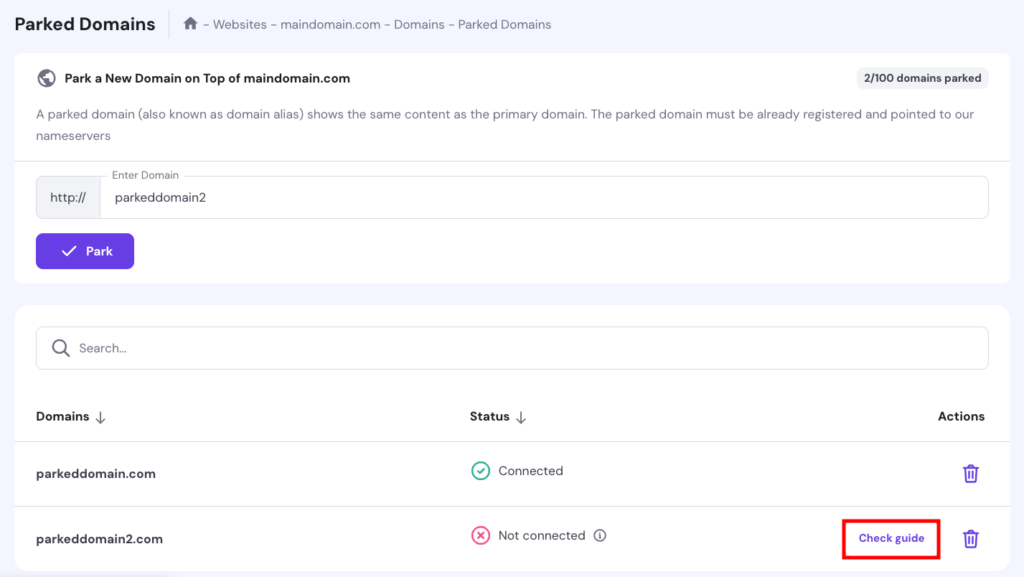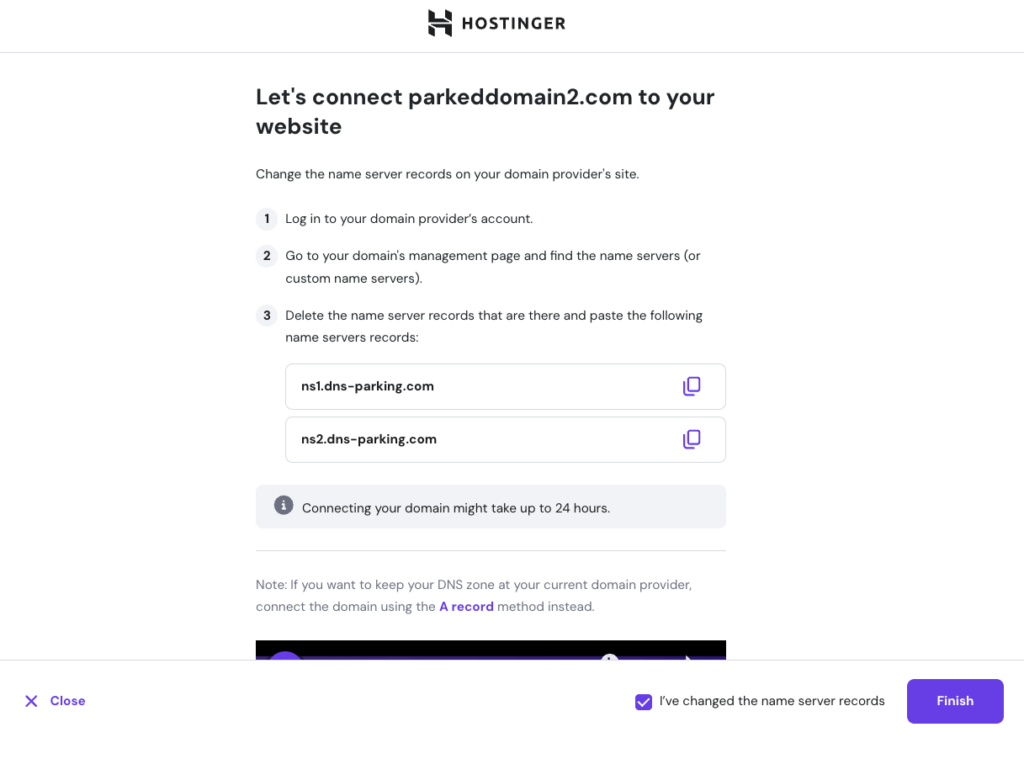Domain parking: What it is and how to use it

Domain parking is a practice of registering a domain name and pointing it to a temporary webpage. Parked domains usually display simple placeholder pages that may show advertisements, a “Coming soon” message, or redirect visitors to another website.
Parking a domain is a great way to protect your brand, especially if you plan to launch a website but need time to develop it. It prevents others from claiming your domain and helps stop competitors from registering similar names. Doing this with multiple domains or niche names also lets you earn passive income through ads while waiting to use or sell them.
We’ll explore how domain parking works in detail, including other benefits beyond brand protection and making money.
Why would you park a domain name?
People park domains for four main reasons: to protect their brand, redirect traffic from similar domains, hold valuable domains as investments for future sale, or to reserve a domain name while planning a future website. This practice is convenient since you can control those domains without building full websites beforehand.
In any case, it starts with checking if the domain is available. Even if you’re not ready to build the website yet, securing the name early is a smart move. In fact, that’s part of the reason why domain parking is so common. According to APNIC, domain parking accounts for 17.5% of all registered domains.
Protecting your digital assets: Securing a valuable domain
Trademarking your brand and its variations lets you legally use them in your industry and helps prevent infringement, but it won’t automatically stop others from claiming similar domain names. While you can challenge these registrations through the Uniform Domain Name Dispute Resolution Policy (UDRP) for infringement, it’s time and effort better spent elsewhere.
That’s where domain parking comes in. It’s an extra step to keep others from registering domains related to your brand, especially if you haven’t trademarked every variation. By parking those domains, you make sure they’re in your control and avoid having your brand used by someone else.
Start brainstorming domain names for your brand and check their availability with a domain checker tool. Ideally, you’ll do this before launching your business, but it’s never too late to secure the right domain.
Domain Name Checker
Instantly check domain name availability.
Redirecting traffic: Guiding users to your primary website
Redirecting parked domains to your website helps you capture traffic from users who misspell the domain in their browser. For example, typing “aple.com” on a browser will redirect you to Apple’s homepage, “apple.com”.
This also works well for regional or campaign-specific domains. You can use them to reach specific audiences or highlight current promotions without having to create separate websites, simplifying navigation and boosting customer experience.
Many businesses use this strategy to boost SEO by funneling traffic to one site. It can also enhance customer experience by simplifying navigation. Plus, this practice gives you valuable insights into domain performance and marketing campaigns, helping you make informed decisions.
Use domain forwarding to redirect your parked domains. It’s easy to set up through your domain registrar’s control panel, where you can choose a 301 redirect for permanent use or a 302 for temporary use.
Alternatively, configure the redirect through your web hosting provider’s DNS settings for more control over the process and to maintain SEO value.
Preparing for sale: Listing your domain for buyers
If you want to make money flipping domains, domain parking is a great way to prepare your asset for sale without having to build a full website. Domain flipping is a business practice of buying a valuable domain and selling it later for profit once the market is right. Instead of leaving your domain unused, parking it keeps it visible and ready for sale.
In the meantime, you can monetize the parked domain through several methods:
- Showing ads on the placeholder page
- Creating a landing page with a contact form to generate leads or build an email list
- Promoting affiliate links related to your domain’s niche

Holding a domain before it expires or for future use
Finding the right domain that fits your brand can be challenging, so it makes sense to buy it as soon as it becomes available. Even if you’re not ready to launch your brand or product yet, purchasing the domain reserves your online space and protects it from being taken by someone else.
In this case, the placeholder page connected to the parked domain usually shows a “Coming soon” message or includes a sign-up form for visitors to receive updates when the site officially launches.
Domain parking is also a great way to keep your domain active and generate passive income, instead of leaving it unused. Enable domain auto-renewal so you don’t lose ownership, and consider monetizing the parked domain with ads or affiliate links.
How does domain parking actually work?
Domain parking lets you reserve a domain name without connecting it to a full website. Many domain registrars offer this service, but the process doesn’t happen automatically when you register a domain. After buying a domain, you’ll need to enable parking through your registrar’s control panel, usually in just a few clicks.
If your registrar doesn’t support parking, you can transfer your domain to a dedicated domain parking service. These services provide advanced tools to manage your parked domain, including custom placeholder pages, monetization options like ads, and extra domain protection features.
At Hostinger, parking a domain allows you to connect it to another website, either by redirecting it or mirroring the content, depending on the type of website you’re using.
- For WordPress websites ‒ When you park a domain, it will act as a redirect. For example, if you park “domain.com” to “domaintest.com,” users who type “domain.com” will be redirected to “domaintest.com.” It’s a simple way to point multiple domains to one website.
- For websites built with PHP/HTML ‒ Parking a domain will mirror the website, keeping the original domain name in the URL while displaying the same website content. This is useful for creating placeholder pages or ensuring multiple domains show the same site content.
Here’s how you can park a domain at Hostinger:
- Log in to your hPanel dashboard for the website you want to mirror or redirect.
- Go to Domains and select Parked Domains.
- Enter the domain in the available field and hit Park.

- All the parked domains will appear on the list below it. To change the status to Connected, click Check guide.

- Follow the steps to point the domain to Hostinger nameservers. If your main website is hosted with us, check the I’ve changed the name server records box and select Finish. Otherwise, do it after making the changes on your domain registrar’s account.

Common types of parked domains
There are three types of parked domains, each serving a different purpose: misspelled, new, and expired domains.
Misspelled domains: Catching those typos
This type of parked domain helps capture traffic from users who accidentally type the wrong URL. Instead of landing on a random website or seeing an error message, they’ll be redirected to your main site.
For example, typing “gogle.com” will bring you to Google’s search page, while searching “aple.com” will direct you to Apple’s homepage.
Fresh or new domains: Securing new opportunities
These domains are parked for future use, whether for an upcoming brand launch or as a digital asset to sell later. Parking them prevents competitors from registering similar domain names that could steal traffic from your brand.
Expired domains: Giving them a new life
Parking soon-to-be-expired domains lets you hold them for resale or use them to redirect traffic to a new project. You can park an expired domain that enters the redemption period (30-60 days after expiration) by renewing it.
Telling the difference: Parked domains vs other domain types
Parked domains are often confused with add-on domains and subdomains. Each type has uses in website management, SEO, and branding, so choosing the right type for your needs is crucial.
An addon domain is a domain name that you add to an existing hosting account, allowing you to host multiple websites under the same account. It works like a separate website but is connected to the main hosting account ‒ perfect for hosting multiple independent websites without buying extra hosting plans.
In contrast, to understand what a subdomain is, think of it as a part of a main domain that serves to organize the website content better. Many domain registrars and hosting providers allow you to create subdomains for free to organize different sections of your website without registering new domains.
For example, you can use “blog.yourdomain.com” for your blog and “store.yourdomain.com” for your store ‒ both are subdomains of “yourdomain.com.” Unlike a parked domain, a subdomain hosts specific content or services, which directly contributes to your SEO efforts.
Making money with domain parking: Cash parking explained
The most common way to monetize a parked domain is by displaying ads or affiliate links on its placeholder page. This is why domain parking is also called cash parking, as you earn passive income whenever visitors click on those links.
What is the average domain parking revenue?
On average, you can earn $1-50/month from a parked domain. However, the actual amount depends on factors like the domain’s quality and niche, ad types, and the parking service’s revenue model. Also, domain parking services usually take a percentage of the revenue as a fee.
How to check if a domain is parked?
You can check if a domain is parked by simply visiting it in your browser. If you see a single page with a “Coming Soon” message, ads, or a notice that the domain is parked, it’s a clear sign that the domain isn’t being actively used.
Another way to check is using a parked domain checker. These tools scan the domain and will tell you if it’s parked. Additionally, some domain parking services list their parked domains for sale on marketplaces like Sedo and Flippa, so it’s worth checking there as well.
Unfortunately, a WHOIS lookup won’t help you determine if a domain is parked. The WHOIS database only provides information about domain registration details, such as who owns the domain, registration date, and expiration date.
Is domain parking legal and safe?
Yes, domain parking is legal and safe. However, domain squatting or cybersquatting ‒ registering domains that are clearly intended to mislead by targeting existing trademarks ‒ can be illegal. If you’re registering similar names, it’s a grey area unless those variations are also protected by trademark law. A good rule of thumb is to use a reputable domain registrar or parking service and always follow their terms of service.
Next steps in domain management
Domain parking is the common practice of registering a domain and holding it with a placeholder page instead of using it for an active website. It’s useful for securing the domain for an upcoming project, protecting your brand from cybersquatting, and capturing traffic from typos.
You can earn passive income from ads or affiliate links while your domain is parked. Adding a contact form to the placeholder page is also a great way to build an email list, helping you prepare for a future brand or product launch.
If you already have a domain in mind, secure it now with Hostinger. With a free domain for a year included in annual hosting plans, you can start developing your project and connect the domain whenever you’re ready to launch.

All of the tutorial content on this website is subject to Hostinger's rigorous editorial standards and values.


